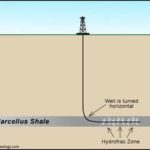 Hydraulic fracturing, or “fracking,” is a method for recovering oil and natural gas from shale rock formations. It has been used for five decades without significant environmental consequence. It was studied by the EPA in 2004 and found to be an acceptable practice that could adequately be regulated by state environmental agencies. Those conclusions, though, were not acceptable to leftward leaning environmentalists or big federal government control freaks.
Hydraulic fracturing, or “fracking,” is a method for recovering oil and natural gas from shale rock formations. It has been used for five decades without significant environmental consequence. It was studied by the EPA in 2004 and found to be an acceptable practice that could adequately be regulated by state environmental agencies. Those conclusions, though, were not acceptable to leftward leaning environmentalists or big federal government control freaks.
Congressmen Henry Waxman (D-CA) and Edward Markey (D-MA), of the House Cap & Trade brigade, called for congressional hearings into the practice in an attempt to have disclosed the minute traces of chemicals injected into the shale, in an attempt to justify concerns about groundwater contamination caused by the practice.
New York State has called for a moratorium, encouraged in part by George Soros, until the groundwater contamination claims can again be refuted.
Now the EPA is taking its best shot, asking major E & P firms and their subcontractors to voluntarily disclose the chemicals used in the fracturing process.
Hydraulic fracturing involves drilling a vertical well, through a drill casing, into shale formations, then turning the well horizontally at the depth where the gas is believed to exist. Water, bearing sand and traces of other inert chemical “proppants” which “prop” open cracks in the shale so the gas can escape, is injected into the well at high pressures to create those cracks. The water may also contain polymers to aid in forcing the water and proppants into those fissures. The polymer blends are considered proprietary, and therein lies the rub. Lisa Jackson’s EPA has sent written requests to nine fracking service providers asking that they “voluntarily and confidentially” disclose the constituencies of those polymers so she can evaluate their threat to drinking water aquifers.
“By sharing information about the chemicals and methods they are using, these companies will help us make a thorough and efficient review of hydraulic fracturing and determine the best path forward,” said EPA Administrator Lisa Jackson. “Natural gas is an important part of our nation’s energy future, and it’s critical that the extraction of this valuable natural resource does not come at the expense of safe water and healthy communities.”
The Haynesville Play in northern Louisiana, where shale formations exist at depths of about 7500 feet, 6000 feet below aquifers in the region, has not suffered much controversy regarding the fracking practices. The Barnett Play near Fort Worth, and moreso the Marcellus Play in West Virginia, Pennsylvania and New York, have been the focus of much greater attention as the shale formations are shallower, thus closer to aquifer elevations. Yet, noting the practice’s fifty year history in all manner of shale formations, John Smith of the LSU Petroleum Engineering faculty told the Baton Rouge Advocate,
“You don’t have 50 years’ history of people complaining about fracture stimulations affecting their water supplies and so forth,” Smith said.
“How much of this is politics, and ill-informed politics, and how much is realistic concern I don’t have a good feel for.”
Nor do we, but we are inclined to believe that a great deal of it is politics, informed and otherwise. Hydraulic fracturing has a long and successful history, and only now, in an era personified by a vocal belief that the federal government should regulate everything, do we hear concerns that the process is a threat to drinking water.
Advertisement
Advertisement

